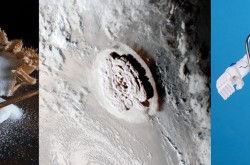3 things you should know about why delaying spring garden cleanup boosts biodiversity, how supernovas embed ancient human history dates in tree rings, and why Jupiter’s moon Europa may support life

Meet Renée-Claude Goulet, Michelle Campbell Mekarski, and Cassandra Marion.
They are Ingenium’s science advisors, providing expert scientific advice on key subjects relating to the Canada Agriculture and Food Museum, the Canada Science and Technology Museum, and the Canada Aviation and Space Museum.
In this colourful monthly blog series, Ingenium’s science advisors offer up three quirky nuggets related to their areas of expertise. For the April edition, they tell us how delaying your spring garden cleanup can give a boost to biodiversity, how finding evidence of heavy cosmic ray bombardments in ancient tree rings is a new way to establish dates in ancient human history, and how the Europa Clipper space mission will help determine if Jupiter’s enigmatic moon can support life.
Delaying your spring garden cleanup can give a boost to biodiversity
With the return of warmer weather, many of us may be itching to get outside and start on our spring tasks like garden and yard cleanups. However, there is a good reason to curb our excitement and hold off just a little longer, allowing time for nature do its thing!
In early spring, when temperatures start to rise and snow disappears, many of our overwintering invertebrates – or bugs – are still hiding away, waiting for things to settle out and for food sources to appear. While some of them overwinter as adults, many of our moths and butterflies overwinter as well-disguised pupae, hidden in leaf litter and on dead stems. Others, such as many species of native bees, hide in burrows in the ground, or inside hollowed stems and wood piles.

One of the best ways to protect insects that might still be overwintering is to leave dead plant material right where it is!
Online, we can find many sources stating we should delay our cleanups until it is consistently 10°C outside, while other sources say there doesn't appear to be much scientific evidence for this guideline. In some parts of the country, 10°C during day and night may not happen until summer is in full swing. It might be difficult for people to follow this well-meaning advice. Instead, we can learn a little more and use our knowledge to help us make decisions about when and how to get to work.
As with many things garden-related, there are no hard and fast rules, especially when accounting for biodiversity. Each species of invertebrate has its unique needs when it comes to development and emergence from dormancy (a period of inactivity). Because insects are cold-blooded, they rely on ambient temperature for their biological activity. They can only develop when exposed to a certain temperature range, outside of which, development stops. Degree days is a concept that agricultural entomologists (people who study bugs) use to determine when insect pests may emerge and thus be the right time to deploy pest monitoring and control strategies. A degree day represents the amount of heat units accumulated over time as calculated starting from a set date – usually January 1. By knowing insects’ required ranges of temperatures for reaching key development stages, and the daily temperatures, we can predict through calculations when they will come out after winter. But since calculating this requires quite a few bits of information and close monitoring of daily temperatures, it is not practical or realistic for the average person who is hoping to avoid disturbing insects.
The good news is we can take another approach; the intensity of cleanup is really key here. Typical tasks associated with early spring, such as pruning back perennials and trees, may not necessarily disturb wildlife. But for many of us, cleaning the garden and yard involves raking up leaves and dead vegetation, bagging it up and putting it out for pickup, which in many cases, may mean throwing away a bunch of "sleeping" and developing insects. If you are to rake, a gentler approach could be to make a littler pile and leave it to decompose, so that whatever is still in your yard gets a fighting chance. You could also use the raked-up debris as mulch in the garden and around trees, which also helps feed the soil ecosystem. But watch out, some critters live in the top inches of the soil too, so it's wise not to completely cover the soil either! An even better option is to cut what needs to be cut and just leave the litter in the garden.
It is also best to avoid working the soil too early, or even at all! To our eyes, the soil may seem rather uniform, but shrink yourself down to bug size, and the first few inches of soil become a rich and organized habitat. Working the soil can destroy burrows and contributes to compaction, that is, soil losing its structure and becoming dense and hard, which is no good for both plants and soil life.
One of the best ways to encourage biodiversity in your yard or garden is to leave an area unmanaged, that is letting it grow wild. This provides cover and native food sources for our invertebrate friends.
A small caveat of this gentle cleaning approach is that though it can help encourage beneficial bugs, it may also help out the ones we don't really want and that we consider pests. However, that is a small price to pay to help others thrive!
So whichever way you decide to approach cleanup this spring, just remember that a small adjustment to our habits can sometimes make big impacts on the critters around us!
By Renée-Claude Goulet
Dating ancient trees using supernovas: an innovative new way to find dates in ancient human history
In 1021 CE, a Viking chopped down a tree in L’Anse aux Meadows, Newfoundland, which was used to build a longhouse. This statement may not seem significant, but the ability to place an exact date on a log from an archeological site represents an innovative new way to find the age of wooden items in the archeological record.
For scientists in many fields, knowing the age of something is critical. It provides vital context about what was going on in the world at the time: environment, animals and plants, climate, and human cultures, technologies, and beliefs of the time.
For these reasons, scientists have developed a range of creative techniques to find the ages of things. From measuring the radioactivity of certain elements and looking for ancient pollen, to watching protein molecules flip over and measuring the magnetism of rocks. Each method varies in how precise it is, the materials it works on, and the age range it can give. However, until now, none could give a precise year.

Trees deposit a new ring in their trunk every year. Analyzing these rings can tell us a lot about the world during the years the tree lived – including major cosmic events.
This new method uses cosmic rays and tree rings to get the job done. Every so often, cosmic events like solar flares bombard the Earth with cosmic rays. When these rays collide with nitrogen gas in the atmosphere, it can create heavier-than-average carbon atoms. When trees breathe in carbon dioxide, they absorb this heavy carbon and store some in their annual rings.
By measuring the carbon in tree rings, scientists can pinpoint which rings (and therefore which years) experienced heavy cosmic ray bombardment. These events are called Miyake events, after Fusa Miyake, who discovered these markers of time within tree rings.
At the time of this article, ten or eleven Miyake events have been identified (a couple still need verification) within the last 15,000 years. Since Miyake events affect the entire planet, they give researchers benchmarks that they can use to pinpoint exact dates in wooden objects around the world – from buildings and ships, to timber and fences.
This technique introduces an unprecedented level of accuracy in dating objects within the last 50,000 years. Reliable written records only go back about 2,500 years and are limited to societies that kept such records. Radiocarbon dating only gives approximate timeframes, not exact years. Exact timelines of ancient civilizations are a big mystery that Miyake events could solve. Questions like: how the Mayan calendar aligns with ours, when the pyramids were built, or when ancient volcanic eruptions destroyed civilizations like the Minoans. It’s one more way to use science to unravel mysteries that have been obscured by the passage of time.
By Michelle Campbell Mekarski
Europa Clipper: Is Jupiter’s enigmatic moon habitable?
The highly-anticipated Europa Clipper mission is on the horizon. Scheduled for launch in October 2024, NASA’s Europa Clipper is expected to reach Jupiter’s moon Europa by 2030 after a five-and-a-half-year journey. The Clipper will orbit Jupiter and conduct dozens of close fly-bys of the icy moon. Its main objectives are to determine if Europa has the potential to support life, to analyze its composition, and to study its geology.

A colour composite view of Jupiter’s moon Europa, taken by the Galileo spacecraft in the 1990s showing the diversity of its surface patterns.
Europa is one of four of Jupiter’s large Galilean moons. It’s about 90% the size of Earth’s Moon, but is a very different world. Europa’s frozen surface is covered in water ice, with temperatures about -200 °C at the poles. The surface terrain is an array of crisscrossing ridges and fractures, and some irregular chaotic terrain resembling ice rafts (see close-up image). Compelling evidence indicates the existence of a vast liquid saltwater ocean kilometres beneath its icy surface, containing significantly more water than all of Earth’s oceans combined. Not only that, scientists suspect there may be hydrothermal heat source below the ocean causing icy eruptions in the form of thin plumes of water, ejected more than 160 km above the surface that the Clipper means to analyze.

Close-up photo of ice rafts on the surface of Europa taken by the Galileo spacecraft in 1998.
How do we know there’s an ocean?
The existence of a subsurface salty ocean is strongly supported by various factors, with one of the most significant being a disturbance in Jupiter’s magnetic field caused by Europa, as identified by the Galileo spacecraft. The disturbance can be explained by an electrically conductive fluid beneath the surface, specifically water. The fracture patterns and lack of tall cliffs or mountains on the surface do not match any models related to tectonics or tides, and would make sense if the surface ice moved independently. The lack of abundant impact craters also suggests that the surface is relatively young and that material may be cycling between the surface and the interior.
Life on Europa?
Based on our current understanding, life needs liquid water, a source of energy such as the Sun, and organic molecules. Remarkably, each of these factors is believed to exist on Europa, rendering it an ideal candidate for verifying the presence of conditions conducive to life on an icy ocean world within the outer Solar System. On top of that, Europa is among four potential ocean worlds that may be capable of supporting life.
The Europa Clipper mission marks a pivotal milestone in unraveling the mysteries of Europa, and the prospect of life beyond Earth. The mission also aims to map out potential landing sites for possible sample collection in the future. Furthermore, the anticipation builds with the forthcoming JUICE mission, poised to investigate Jupiter's other icy moons. Just imagine what we’ll soon discover!
By Cassandra Marion
Enjoying the Ingenium Channel? Help us improve your experience with a short survey!








































